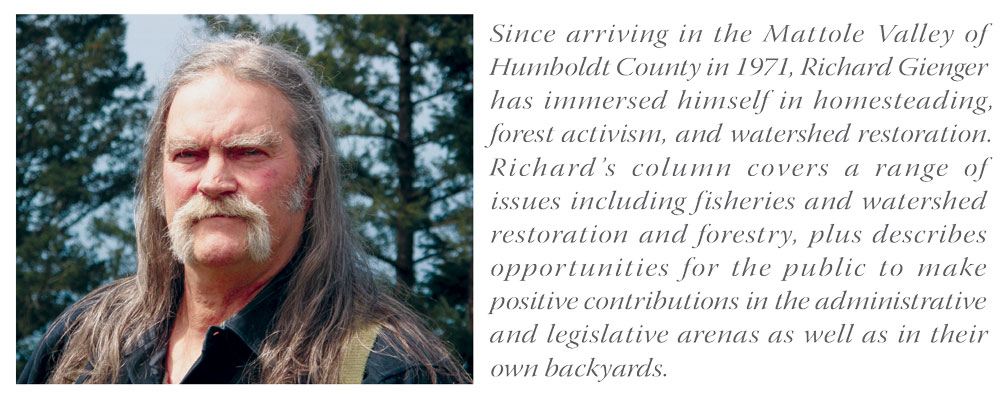Diggin' In
The Richard Gienger Report
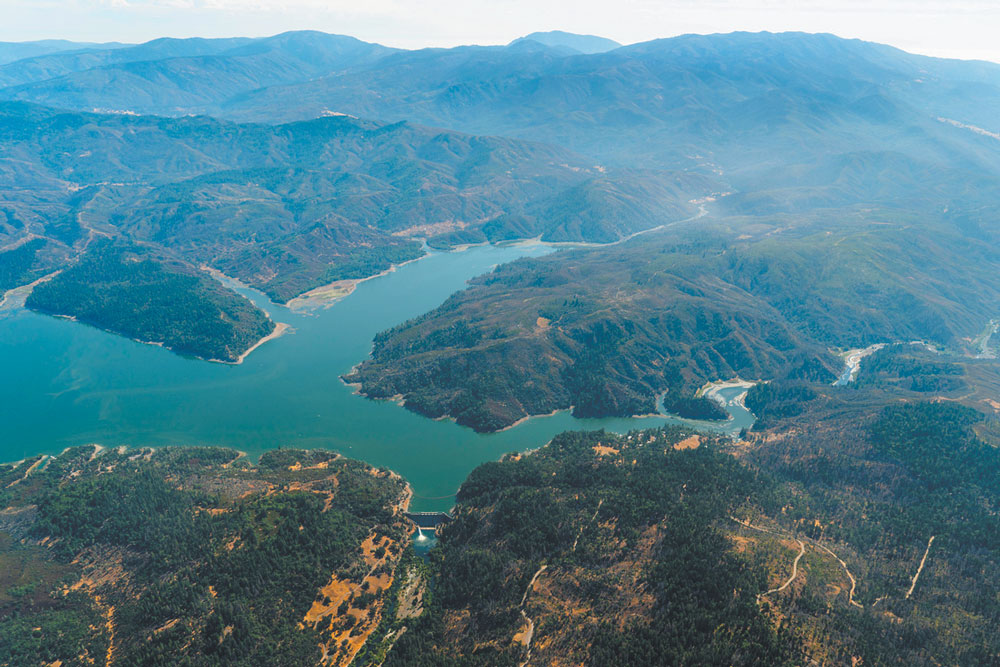
The following is an open letter I wrote in early December 2023. It remains valid today and in the coming months and years as an effort to reform (“modernize”) forest stewardship that includes a model of co-management. Perhaps the most appropriate and pressing place to achieve this is the 50,000-acre Jackson Demonstration State Forest (JDSF). The issues need the light of day, education, public awareness, and participation to achieve a high-standard model that is essential for future forests in California.
A CLARION CALL
The Struggle in Jackson Demonstration State Forest for Real Forest Conservation and Protection, Real Relationship Reform, and Real Co-Management: A Model & Template for the Future of California Forests and People
To Whom It May Concern:
This is not a simple matter, but it needs your attention and participation. You may be vague on all details, the history of centuries, the history since World War II, and the particulars of cultural impacts on forests and people.
To be extremely brief: The forests and peoples of North America were systematically adversely impacted from the Atlantic to the Pacific. Before, during, and after any gold rush there was the almost complete economic exploitation of the forest. (For a strikingly horrifying portrayal of this, read Barkskins by Annie Proulx.)
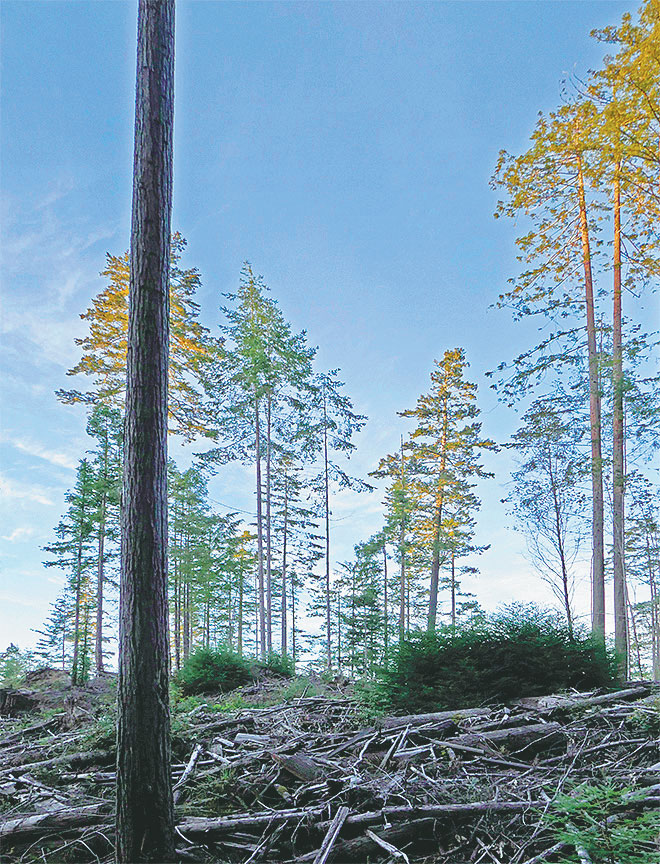
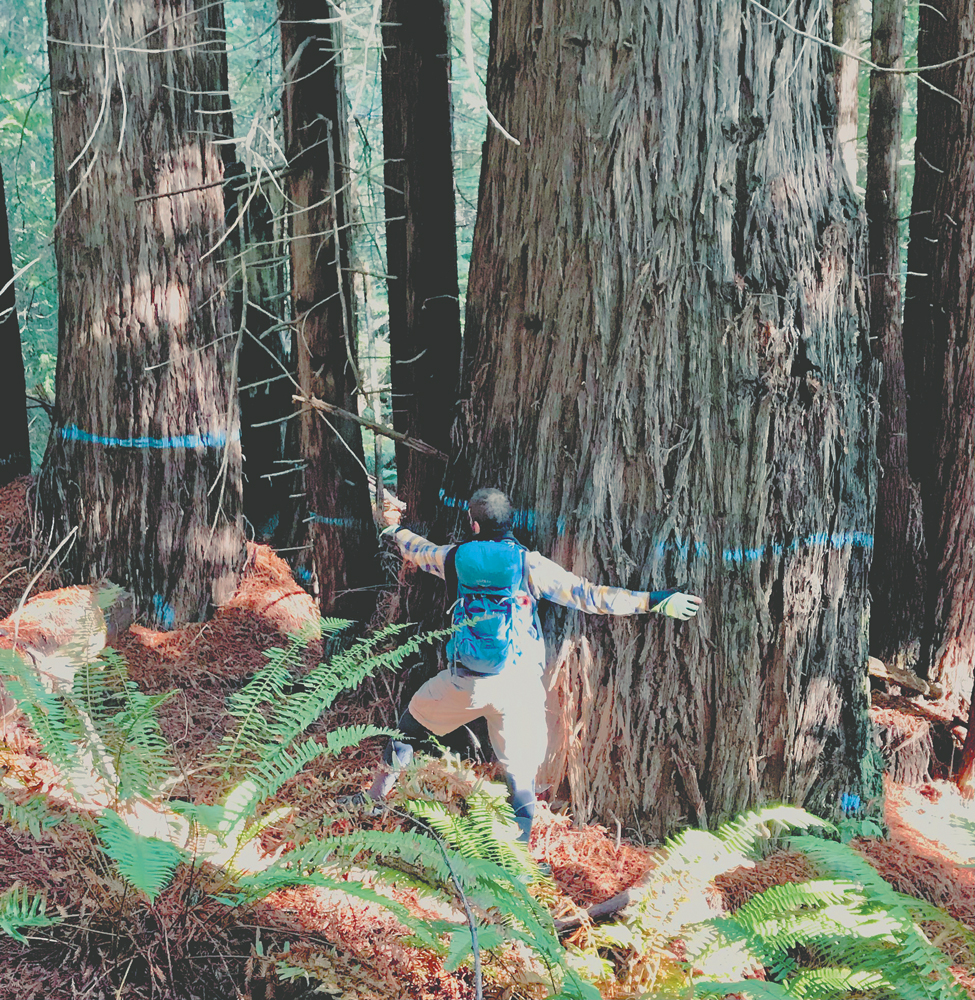
Photos courtesy Mendocino Trails Stewards
Jumping to the West Coast, as did the “timber barons,” from Pennsylvania to Michigan, to Washington State, Oregon, and California in the 19th century: Company towns and the unrelenting logging of the incredible large trees and ancient conifer forests did not really end until those forests and trees were gone, with few exceptions. Official studies in California projected “terminal depletion” by the late 1970s, which was basically confirmed.
After WWII the timber rush was on for real to feed the post-war building boom. There has been and continues to be no meaningful regulation to protect and conserve forests, water, wildlife, cultural heritage, and soil. I heard from former CAL FIRE Director Richard Wilson, an outstanding conservationist, that when timber industry leaders met close to the end of the war they were spoken to by Emanual Fritz. Professor Fritz lived to be over 100, passing in 1988, and was one of the most influential persons in engagement with forests on a professional and ethical basis. Instead of the expected thanks for the industry’s support of the war effort, Fritz encouraged them to support acquiring the vast areas of cutover, burned-over forests in California for a State Forest system. The industry basically dug in its heels to try to prevent this type of State Forest after acquisition of the 50,000-acre Jackson Demonstration State Forest. On top of this, the California legislature passed into law and policy in 1946 the ad valorem tax whereby forest landowners were taxed yearly on their standing timber until 70% was cut. This tax was in place until 1976.
After the massive damage, especially to areas where tractor-logging had mauled cutover forests was intensified by the 1955 and 1964 100-year floods, it was obvious
that serious change was necessary and California responded. Nationally similar and parallel changes occurred. All of a sudden you needed more than a caterpillar tractor and a chainsaw, and the ability to use them, to take the forest down.
There have been many books, investigations, and reports done regarding the California forest situation, from before the passage of the Z’berg-Nejedly Forest Practice Act of 1973 to the present. I recommend your careful and judicious immersion in all that with adequate breaks and fresh air. Despite the multidisciplinary review and standards ostensibly in place now, the high-stakes pressure exerted by industry during the writing of the 1973 FPA resulted in a system not based on prescribed standards but on “professional discretion.” Although certain essential reforms were made (like the usual size of clearcuts reduced from 120 to 30 acres), and the taboo against no-cut stream buffers broken, the dominant industry model is now 30-acre clearcuts every 45 years.
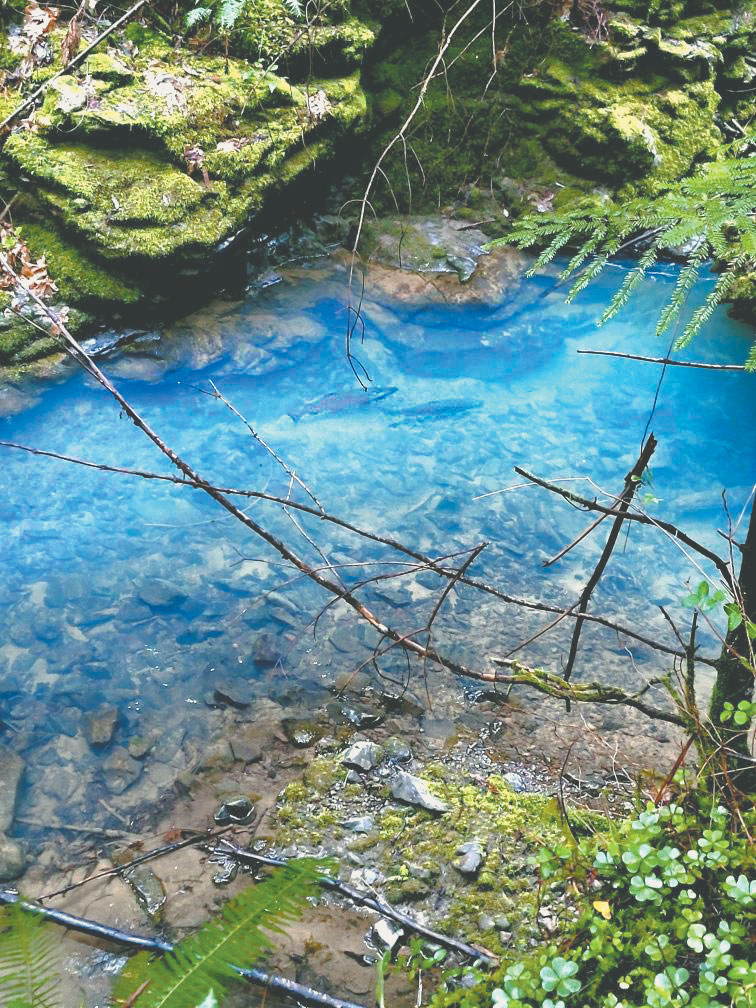
Enter Jackson Demonstration State Forest, the largest and flagship forest of the State Forest system: It has had an ebb and flow of controversy since its purchase of almost 50,000 acres in 1947, and its establishment as a demonstration forest in 1949. It was first criticized as worthless cutover land, to not being logged enough, to having scientific value, to having “economic fingers” on the scale of that value. It gets pretty complicated and contentious. JDSF does have quite a scope of public “multiple uses,” including two Conservation (Fire) Camps run by the California Department of Correction and Rehabilitation jointly with CAL FIRE, the National Historic Landmark Mendocino Woodlands State Park, the Caspar Creek Experimental Watershed (partners Pacific Southwest Research Station [PSW] of the U.S. Forest Service and CAL FIRE), an extensive campsite and trails system, and a lot of “working forest” under variable protections and impacts.*
*For an extensive overview of Jackson written by the acclaimed and accomplished William Lemos, go to this link: tinyurl.com/HowManySalmonEggs for “How Many Salmon Eggs per Board Foot Problem.”
The public continues to be skeptical of the adequacy of Jackson’s forest management. Sound litigation by Vince Taylor and the Campaign to Restore Jackson State Forest challenged Jackson’s inadequate management plan and stopped timber operations from 2001 to 2008. (For more complete facts and perspective, see Trees Foundation’s website, tinyurl.com/ThenandNowCRJSF).
The upshot is that the command and control structure of CAL FIRE and the Board of Forestry over the Jackson Advisory Group (JAG) remains in place. The same structure that overrode the five-year hard-achieved consensus for a new management plan in 2011 by the JAG is ready to clamp down again. That structure includes a lack of transparency as well as a lack of effective, equitable, meaningful public and tribal participation; with an overriding commitment to timber production.
The crucial context is the hard trail to transform the “business-as-usual” resource extraction and plantation/industrial juggernaut into long-term relationships that allow real recovery of forests, watersheds, and human (and beyond human) life—a multigenerational social and cultural reconnection. If this sounds too “woo-woo,” you haven’t worked to challenge the accepted depredation of the forests, waters, hillsides, and people, which has been gradually changed in some places, some of the time. Many are under the impression that JDSF is at the forefront of good forest management, despite immense redwood logs on logging trucks that dwarf the normal bundles of small logs from large private industrial operations. This is a nearsighted and entirely incomplete estimation of the value of JDSF and the value it has as a model and goalpost for the future.
Management of Jackson is way behind the curve to respond to basic adjustments for climate impacts. It is also way behind on comprehensive efforts for watershed and stream and road impact recovery. A big deal is made to correct a road at a stream crossing that has been illegally blocking anadromous salmonid passage for decades. Where is the blueprint example for forest and watershed recovery on the whole of Jackson that is feasible and transferable?
In large part the recent focus, and essentially a Second Campaign to Restore Jackson State Forest, began in March 2020 when some of the Mendocino Trail Stewards became deeply alarmed by massive redwood trees (some over 6 feet in diameter) marked for cutting along some of their favorite trails. Resistance to Timber Harvest Plans (THPs) picked up, and some folks from the region and beyond undertook non-violent civil defense.
Part of the response was the call for changing the almost exclusively timber-cutting mandate of the legislation creating JDSF. Along with this response was the initiative taken by the Coyote Valley Pomo to protect cultural and sacred sites—and to implement Governor Gavin Newsom’s 2020 Statement of Administrative Policy: “. . . it is the policy of this administration to encourage every State agency, department, board, and commission, subject to my executive control to seek opportunities to support California tribes’ co-management of and access to natural lands that are within a California tribe’s ancestral land and under the ownership or control of the State of California.”
All this shook up accustomed norms for the politicians and administrators. THP operations were affected, and some were curtailed. Inadequate measures had been taken and cultural sites were not protected to the degree that those affected deemed necessary. The Betts Report (1999), which called for no operations until cultural impacts, especially by roads, were corrected or avoided, had been ignored.
There continue to be multiple events, responses, and counter-responses. The JAG meetings and critical THP issues are all orchestrated by CAL FIRE and BoF in attempts to maintain the status quo and set tribal and public interests against one another. With fancy language help from the California Natural Resources Agency (CNRA), up popped the “New Vision” paper (little or no public/tribal role) claiming that great things were being done to basically continue approvals THP by THP, project by project, if adherence to the “New Vision” could be alleged. It was a masterpiece of propaganda. For details search “Jackson” at wildfiretaskforce.org. In an August 2022 press release CAL FIRE trumpets “a renewed focus on climate science, restoration ecology and a new model for tribal co-management,” yet implementation of these claims is flawed or lacking.
This “New Vision” actually further postponed timely transparent and participatory progress for getting a new/modernized management plan with co-management so that broad reforms could be implemented. The generally short-sighted, small view, small-scope actions continued—with ample intense CAL FIRE public relations efforts. Some of these actions included proposing 80 acres of co-management, proposing some number of larger so-called PET* trees to be left on certain acres, some fire-oriented projects with limited consultation—but these actions did include the addition of three new JAG members, one from Save-the-Redwoods League, a coastal Pomo representative, and a local timber operator. More recently a Tribal Advisory Group has been started, but the basic precepts of co-management have not been determined, and a key report by the JAG Tribal Relations Subgroup in May 2022 remains in limbo.
* Three PET variations appeared: Potential Elite, Potential Elder, and Permanent Ecological.
To bring this drama and crisis up to date: During 2023, starting around March, CAL FIRE bandied about documents for the “Scope of Work” to be done to establish a new management plan with co-management. This is intended to be handled by a contractor that CAL FIRE/BoF/CNRA will select. This seems to further isolate what needs to be done with input from the public and tribes and to absolve CAL FIRE/BoF/CNRA from the work that they should be doing. One could say that the future of Jackson State Forest, which is directly connected to the future and recovery of California forests, is at least as important as the future and recovery of anadromous salmon and steelhead. In large part, the actions to protect and recover those fish were guided by a select group of insightful and engaged scientists, not a contractor, that thoroughly consulted the whole range of stakeholders and examined conditions and needs. They produced a report that supported and resulted in key changes (Anadromous Salmonid Protection Rules) called Report of the Scientific Review Panel on California Forest Practice Rules and Salmonid Habitat.
One of my points is that the future of Jackson and its management/co-management needs to be determined by a much higher process, and perspective, than that offered by the standard command and control of CAL FIRE and the Board of Forestry. The vested interest of CAL FIRE and the Board of Forestry has been overwhelmingly resistant over time to changes that also happen to be opposed by industry, whether it be evaluation and response to cumulative impacts, true sustainability, adjustments for climate considerations, authority to require restoration, or cultural respect and protection.
This is probably the last opportunity to leverage essential long-resisted reforms regarding true sustainability, adequate protections, and recovery for forest, watershed, and cultural values. This includes specifics like true and effective evaluation and response to cumulative impacts, true consultation with Indians and Tribes, and true protection and respect for the Native American Heritage of California. These are three of the four parts of the EPIC & IITC decision by the California Appeals Court in 1985, which has fallen short of adequate implementation. Jackson is obviously a place where a model of these reforms, which include co-management, can and should occur, which can be applied as appropriate wherever possible in California.
Richard Gienger,
On behalf of Forests Forever and as a Member of the Sierra Club Redwood Chapter of Northern CA Forest Committee
The Scoop
- Some substantive Coho runs occurred in some North Coast streams this season, including tributaries of Indian Creek whose confluence with the South Fork Eel River is directly across from old Piercy.
- Regionally heavy rain, snow, and high-impact storms that could result in more flooding, topographical changes, and damage to homes may continue until late spring. One recent violent storm resulted in lightning shattering a tree next to the Leggett Post Office, leading to its destruction by fire.
- The 3,000 acres acquired by Save-the-Redwoods League along the coast between Usal and Rockport, including Cottoneva Creek, may well become an example of co-management and/or landback with tribes.
- The three dams remaining in the Klamath will be removed this year. The first was taken out
in 2023. Removal of the two dams on the upper Eel River may be accomplished within several years as well! - The California Department of Fish & Wildlife is making available forms to apply for beaver transmigration to Coho streams near you. Step up and fill one out with your watershed neighbors. CFW Beaver site: wildlife.ca.gov/Conservation/Mammals/Beaver
- The Wailaki and other tribes along the Eel River and elsewhere are working to keep the proposed Redwood Trail from adversely threatening cultural heritage, health, and human safety through a flawed process with no basic, from the get-go, consultation on the most remote portions of the trail.
- Use of fire, Traditional Ecological Knowledge, and right-livelihood recovery of forests and watersheds are alive and well in Northern California—a hotspot being the region of Northern Mendocino and Southern Humboldt counties.
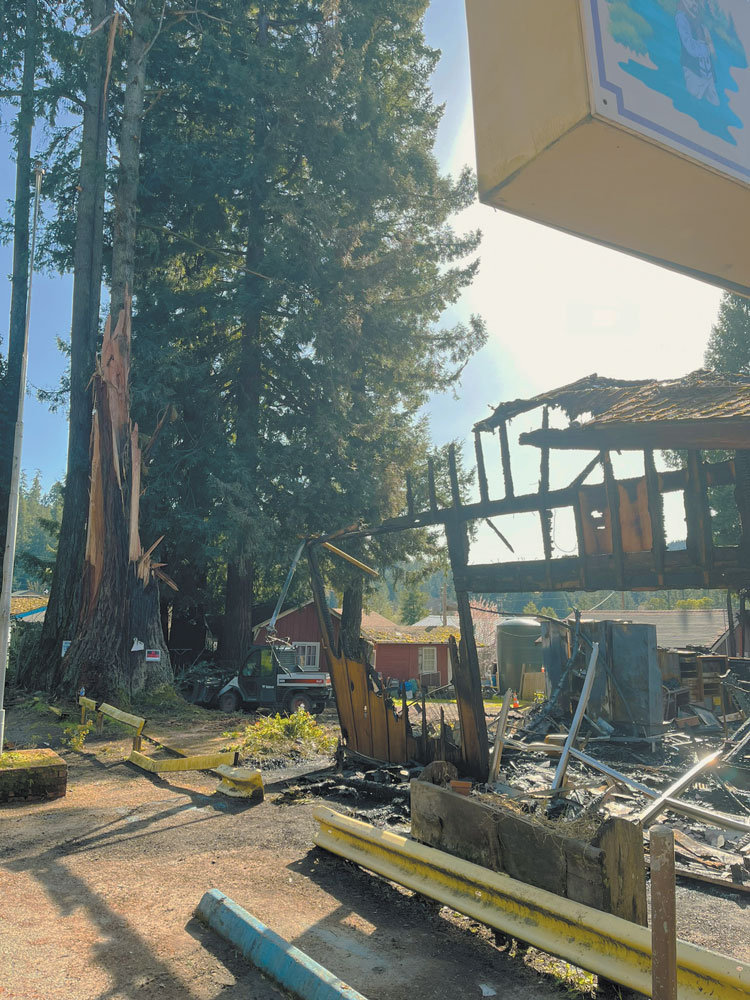
Please help out where and when you can on all the issues before us. Check out the work of Sanctuary Forest, the Institute for Sustainable Forestry, EPIC, Forests Forever, Redwood Forest Foundation, Inc., and Save California Salmon.
Additional important/essential information:
Documentation of the Board of Forestry rejection of the 2011 Jackson Advisory Group (JAG) unanimous consensus management plan—and a lot of the history of the 2001–2011 saga: https://www.jacksonforest.com/
Vince Taylor’s letter of resignation from the JAG to the Board of Forestry: https://www.jacksonforest.com/JAG/2011-09-05%20Resignation%20Taylor%20to%20BOF%20.pdf
Vince Taylor’s letter of resignation from the JAG to CAL FIRE Director Pimlott: https://www.jacksonforest.com/JAG/2011-09-06%20Resignation%20Taylor%20to%20Pimlott.pdf
Vince Taylor’s February 2022 paper with endnotes RE: JDSF: https://www.jacksonforest.com/Publications/JDSF%20-%20a%20tale/Jackson%20Demonstration%20State%20Forest%20KEY%20v6-14pt%20desktop.pdf
A key letter from JP O’Brien, Ph.D. (Climate Scientist, Lawrence Berkeley National Laboratory, Mendocino Coast Resident) and Stephen C. Sillett. Ph.D., Professor, Kenneth L. Fisher Chair in Redwood Forest Ecology, Cal Poly Humboldt: https://drive.google.com/file/d/1xt0nuZBf7Tlf2yzFDHRMlgdmk20fWoGU/view?usp=drive_link
Link: https://wildfiretaskforce.org/wp-content/uploads/2022/09/JDSF-Modernization-Vision-8.18.22FINAL.pdf
To Get Involved
Richard Gienger, [email protected], 707/223-6474
Institute for Sustainable Forestry, instituteforsustainableforestry.com
Forests Forever, www.forestsforever.org
Mendocino Trails Stewards, mendocinotrailstewards.org
Redwood Forest Foundation, Inc., www.rffi.org
Sanctuary Forest, sanctuaryforest.org
Save California Salmon, www.californiasalmon.org
Save Jackson Coalition, savejackson.org
